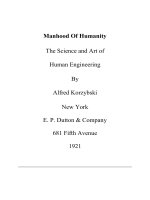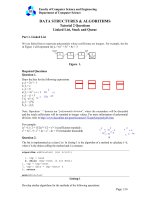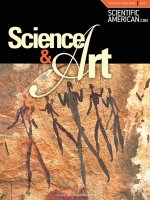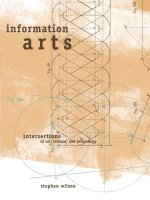Writing task 2 8.5+ 9899 art vs science and business
Bạn đang xem bản rút gọn của tài liệu. Xem và tải ngay bản đầy đủ của tài liệu tại đây (185 KB, 8 trang )
Overall band score
8.5
9+8+8+9
See below C&C LR GRA
Model answer
WRITING TASK 2
You should spend about 40 minutes on this task.
Write about the following topic:
For a long time, art has been considered an essential part of all cultures in the
world. However, nowadays people’s values have changed, and we tend to
consider science, technology and business more important than arts.
Why is this the case?
What can be done to draw people’s attention to art?
Give reasons for your answer and include any relevant examples from your own
knowledge or experience.
Write at least 250 words.
Original answer It is widely recognized that art has been an integral part of human society since
ancient times, serving as a medium for expressing emotions and reflecting
cultural beliefs. However, in recent years, there has been a shift in people's
priorities, with a greater emphasis being placed on science, technology, and
business and less on the arts. This essay will outline the underlying causes of this
trend, before suggesting how to make people appreciate art more.
Perhaps the foremost reason for the devaluation of art would be the increasing
focus on practicality and materialism. In today's fast-paced world, people tend to
prioritize efficiency, productivity, and financial success over creative, artistic
expression. This can be seen in the way the modern job market often favors
candidates with technical skills and business acumen over ones with artistic
abilities. For this reason, young people are often encouraged to pursue STEM
subjects (that is, science, technology, engineering, and math) over the arts, as the
former is believed to lead to more lucrative career paths.
Given the aforementioned reasons, the following steps should be taken to make
the arts more appealing. First, it is important that the government mount more
educational campaigns aimed at showcasing the practical value of art, such as by
illustrating how advertising and architecture are inspired by the arts. People, once
fully cognizant of these practical applications, would be more likely to appreciate
its value and thus pay more attention to it. This measure should be executed in
tandem with exposing young children to art. Research has suggested that the
earlier children are introduced to different art forms, the more likely they can
develop a sense of appreciation and a lifelong interest in art. Such a two-pronged
approach could arguably go a long way towards drawing people’s attention back
to the arts.
To summarize, the increasing emphasis on practical and material aspects seems
to be the root cause of people today tending to prioritize science, technology, and
business over the arts. Considering this, the government should ramp up its effort
to show the practicality of art, as well as educating young children about it. By
doing so, people’s attention could be potentially drawn back to the arts.
Overall band score
8.5
9+8+8+9
TR – Task Response nb – GRA and LR errors have not been corrected
Band score 9
This is a difficult question and it’s an excellent answer. It’s not clear from the
wording of the question whether it’s about art or the arts, which include music,
theatre, literature, etc. I think it’s more likely to be about the latter, but as it’s not
clear, it’s ok for you to conflate them.
You have a clear position throughout and all parts of the question are addressed.
Your position is coherent and well-argued. The ideas are relevant, extended, and
coherent.
Other information
The lack of interest in art is an indication of civilization in decline.
We’ve gone from this and this to this The same applies to music,
etc. Maybe we reached our peak at the end of the 19th century.
The only question is whether the decline is natural or done
deliberately
Advice On Brainstorming For Task 2
As you’re planning and writing your answer, remember to constantly
ask yourself if you’re answering the question. Check back to the
question a few times as++ you think of ideas to make sure they're
directly relevant.
Make sure your introduction directly addresses the
question.
Make sure your ideas address all parts of the question. If
the question asks for solutions, in the plural, you must
suggest at least 2.
Make sure your main ideas, as stated in the first sentence
of the main body paragraphs, are directly relevant to the
question.
Make sure your supporting ideas, which follow the main
ideas in the main body paragraphs, directly support the
main idea.
Be especially careful if you’ve answered similar question
before, as there will always be important differences.
Make sure your conclusion directly answers the question,
that it is consistent with the ideas in the main bodies, and
that it does not contradict the introduction.
It is widely recognized that art has been an integral part of human society since
ancient times, serving as a medium for expressing emotions and reflecting
cultural beliefs. However, in recent years, there has been a shift in people's
priorities, with a greater emphasis being placed on science, technology, and
business and less on the arts. This essay will outline the underlying causes of this
trend, before suggesting how to make people appreciate art more.[a]
Perhaps the foremost reason for the devaluation of art would be the increasing
focus on practicality and materialism[b]. In today's fast-paced world, people tend
to prioritize efficiency, productivity, and financial success over creative, artistic
expression. This can be seen in the way the modern job market often favors
candidates with technical skills and business acumen over ones with artistic
abilities. For this reason, young people are often encouraged to pursue STEM
subjects (that is, science, technology, engineering, and math) over the arts, as the
former is believed to lead to more lucrative career paths.[c]
Given the aforementioned reasons, the following steps should be taken to make
the arts more appealing[d]. First, it is important that the government mount more
educational campaigns aimed at showcasing the practical value of art, such as by
illustrating how advertising and architecture are inspired by the arts. People, once
fully cognizant of these practical applications, would be more likely to appreciate
its value and thus pay more attention to it. This measure should be executed in
tandem with exposing young children to art. Research has suggested [e]that the
earlier children are introduced to different art forms, the more likely they can
develop a sense of appreciation and a lifelong interest in art. Such a two-pronged
approach could arguably [f]go a long way towards drawing people’s attention back
to the arts. [g]
To summarize, the increasing emphasis on practical and material aspects seems
to be the root cause of people today tending to prioritize science, technology, and
business over the arts. Considering this, the government should ramp up its effort
to show the practicality of art, as well as educating young children about it. By
doing so, people’s attention could be potentially drawn back to the arts.[h]
C&C - Cohesion and Coherence nb GRA and LR errors have not been corrected
Band score 8
The organisation is excellent and easy to follow.
The paragraphs have a natural flow of ideas and clear central topics.
Use of cohesive devices and referencing is excellent throughout.
Paragraphing for Task 2
I recommend you write 4 paragraphs as follows:
Write an introduction, that explains what the question is.
After reading the introduction, the reader should have a
good idea what the essay is about, and what your position
(opinion) is. It should be possible to write an introduction in
under 50 words. It is not necessary to write a long
background statement.
Write 2 main body paragraphs. This should allow you to
expand on the ideas sufficiently to persuade the examiner
that you’ve fully supported the main ideas. If you write 3
main bodies, it is more difficult to expand and support them
sufficiently to get a high score.
If it’s a two-part question, answer the questions in the order
they’re given and write one paragraph per question.
The main body paragraphs should be 100-120 words, and
each paragraph should have a clear topic sentence and 2 or
more supporting ideas which support the topic sentence with
reasons, evidence, and examples. Do not waste time with
lots of background information.
The topic sentences should directly address the question.
The conclusion should be consistent with the introduction
and the main ideas, and it should not introduce new ideas. It
should directly answer the question. Do not leave the
examiner in any doubt about whether you’ve answered the
question.
If you write a third paragraph in a discuss both sides question
to clarify your position, make sure that give a good reason to
reject one of the sides. If you just restated the original ideas
about one side, the examiner may decide you have covered
one side more than the other.
It is also ok to write a third body paragraph in a to what
extent question if you have main ideas which both agree and
disagree with the proposition. Avoid short paragraphs, with
under 70 words, as it may be difficult to show a clear central
topic in a short paragraph.
It is widely recognized that art has been [i]an integral part of human society since
ancient times, serving as [j]a medium for expressing emotions and reflecting
cultural beliefs. However, in recent years, there has been a shift in people's
priorities, with a greater emphasis being placed on [k]science, technology, and
business and less on the arts. This essay will outline the underlying causes of this
trend, before suggesting how to [l]make people appreciate art more.
Perhaps the foremost reason for the devaluation of art would be the increasing
focus on practicality and materialism[m]. In today's fast-paced world, people tend
to [n]prioritize efficiency, productivity, and financial success over creative, artistic
expression. This can be seen in the way the[o] modern job market often favors
candidates with technical skills and business acumen over ones with artistic
abilities[p]. For this reason, young people are often encouraged [q]to pursue STEM
subjects (that is, science, technology, engineering, and math) over the arts, as the
former is [r]believed to lead to more lucrative career paths.
Given the aforementioned reasons, the following steps should be taken to make
the arts more appealing. [s]First, it is important that the government mount
more [t]educational campaigns aimed at showcasing the practical value of art, such
as by [u]illustrating how advertising and architecture are inspired by the
arts. People, once fully cognizant of these practical applications, would be more
likely to [v]appreciate its value and thus pay more attention to it. This measure
should be executed in tandem with [w]exposing young children to art. Research has
suggested that the earlier children are introduced to different art forms, the more
likely they can develop a sense of appreciation and a lifelong interest in art. Such
a two-pronged approach could arguably go a long way towards drawing people’s
attention back to the arts.
To summarize, the increasing emphasis on practical and material aspects seems
to be the root cause of people today tending to [x]prioritize science, technology,
and business over the arts. Considering this, the government should ramp up its
effort to show the practicality of art, as well as educating young [y]children about
it. By doing so[z], people’s attention could be potentially [aa]drawn back to the arts.
LR- - Lexical resource nb Some GRA errors have not been corrected
Band score 9
Vocabulary is used accurately with sufficient flexibility to show precise meaning,
with a wide variety of vocabulary, used accurately and with a high level of control.
It is widely recognized that art has been an integral part of human society since
ancient times, serving as a medium for expressing emotions and reflecting
cultural beliefs. However, in recent years, there has been a shift in people's
priorities, with a greater emphasis being placed on science, technology, and
business and less on the arts. This essay will outline the underlying causes of this
trend, before suggesting how to make people [ab]appreciate art more.
Perhaps the foremost reason for the devaluation of art would be the increasing
focus on practicality and materialism. In today's fast-paced world, people tend to
prioritize efficiency, productivity, and financial success over creative, artistic
expression. This can be seen in the way the modern job market often favors
candidates with technical skills and business acumen over ones with artistic
abilities. For this reason, young people are often encouraged to pursue STEM
subjects (that is, science, technology, engineering, and math) over the arts, as the
former is believed to lead to more lucrative career paths.
Given the aforementioned reasons, the following steps should be taken to make
the arts more appealing. First, it is important that the government mount more
educational campaigns aimed at showcasing the practical value of art, such as by
illustrating how advertising and architecture are inspired by the arts. People, once
fully cognizant of these practical applications, would be more likely to appreciate
its value and thus pay more attention to it. This measure should be executed in
tandem with exposing young children to art. Research has suggested that the
earlier children are introduced to different art forms, the more likely they can
develop a sense of appreciation and a lifelong interest in art. Such a two-pronged
approach could arguably go a long way towards drawing people’s attention back
to the arts.
To summarize, the increasing emphasis on practical and material aspects seems
to be the root cause of people today tending to prioritize science, technology, and
business over the arts. Considering this, the government should ramp up its effort
to show the practicality of art, as well as educating young children about it. By
doing so, people’s attention could be potentially drawn back to the arts.
GRA – Grammatical range and accuracy nb Some LR errors have
not been corrected
Band score 9
Grammar is used accurately with a wide variety of structures, which should be
good for a band score 9.
Punctuation is used correctly throughout.
Appropriate structures are used throughout.
It is widely recognized that art has been an integral part of human society since
ancient times, serving as a medium for expressing emotions and reflecting
cultural beliefs. However, in recent years, there has been a shift in people's
priorities, with a greater emphasis being placed on science, technology, and
business and less on the arts. This essay will outline the underlying causes of this
trend, before suggesting how to make people appreciate art more.
Perhaps the foremost reason for the devaluation of art would be the increasing
focus on practicality and materialism. In today's fast-paced world, people tend to
prioritize efficiency, productivity, and financial success over creative, artistic
expression. This can be seen in the way the modern job market often favors
candidates with technical skills and business acumen over ones with artistic
abilities. For this reason, young people are often encouraged to pursue STEM
subjects (that is, science, technology, engineering, and math) over the arts, as the
former is believed to lead to more lucrative career paths.
Given the aforementioned reasons, the following steps should be taken to make
the arts more appealing. First, it is important that the government mount more
educational campaigns aimed at showcasing the practical value of art, such as by
illustrating how advertising and architecture are inspired by the arts. People, once
fully cognizant of these practical applications, would be more likely to appreciate
its value and thus pay more attention to it. This measure should be executed in
tandem with exposing young children to art. Research has suggested that the
earlier children are introduced to different art forms, the more likely
they can [ac]develop a sense of appreciation and a lifelong interest in art. Such a
two-pronged approach could arguably go a long way towards drawing people’s
attention back to the arts.
To summarize, the increasing emphasis on practical and material aspects seems
to be the root cause of people today tending to prioritize science, technology, and
business over the arts. Considering this, the government should ramp up its effort
to show the practicality of art, as well as educating young children about it. By
doing so, people’s attention could be potentially drawn back to the arts.









